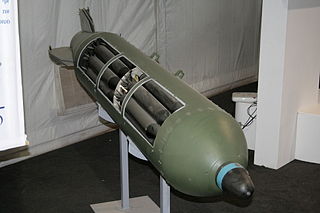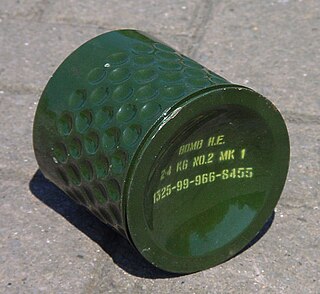The GATOR mine system is a United States military system of air-dropped anti-tank and anti-personnel mines developed in the 1980s to be compatible with existing cluster dispensers. It is used with two dispenser systems—the Navy 230 kg (500 lb) CBU-78/B and the Air Force 450 kg (1,000 lb) CBU-89/B. Additionally the mines are used with the land- and helicopter-based Volcano mine system.
Operation Igloo White was a covert United States joint military electronic warfare operation conducted from late January 1968 until February 1973, during the Vietnam War. These missions were carried out by the 553rd Reconnaissance Wing, a U.S. Air Force unit flying modified EC-121R Warning Star aircraft, and VO-67, a specialized U.S. Navy unit flying highly modified OP-2E Neptune aircraft. This state-of-the-art operation utilized electronic sensors, computers, and communications relay aircraft in an attempt to automate intelligence collection. The system would then assist in the direction of strike aircraft to their targets. The objective of those attacks was the logistical system of the People's Army of Vietnam (PAVN) that snaked through southeastern Laos and was known as the Ho Chi Minh Trail.

The Butterfly Bomb was a German 2-kilogram (4.4 lb) anti-personnel submunition used by the Luftwaffe during the Second World War. It was so named because the thin cylindrical metal outer shell which hinged open when the bomblet deployed gave it the superficial appearance of a large butterfly. The design was very distinctive and easy to recognise. SD 2 bomblets were not dropped individually, but were packed into containers holding between 6 and 108 submunitions e.g. the AB 23 SD 2 and AB 250-3 submunition dispensers. The SD 2 submunitions were released after the container was released from the aircraft and had burst open. Because SD 2s were always dropped in groups the discovery of one unexploded SD 2 was a reliable indication that others had been dropped nearby. This bomb type was one of the first cluster bombs ever used in combat and it proved to be a highly effective weapon. The bomb containers that carried the SD 2 bomblets and released them in the air were nicknamed the "Devil's Eggs" by Luftwaffe air and ground crew.

Anti-runway penetration bombs are explosive weapons involving bombs or bomblets designed to damage or destroy runways, or otherwise render them unusable for aircraft.

The CBU-97 Sensor Fuzed Weapon is a United States Air Force 1,000-pound (450 kg)-class freefall Cluster Bomb Unit. It was developed and produced by Textron Defense Systems. A CBU-97 used in conjunction with the Wind Corrected Munitions Dispenser guidance tail kit is converted to a precision-guided weapon, and the combination is designated CBU-105.

The Mk 20 Rockeye II, CBU-99 Rockeye II, and CBU-100 Rockeye II comprise an American cluster bomb family which are employed primarily in an anti-tank mode against armored vehicles.

The CBU-24 is an unguided, aircraft delivered anti-personnel and anti-materiel weapon developed by the United States. Because it is an unguided weapon, the CBU-24 can be carried and dropped by any aircraft capable of carrying standard "dumb" or "iron" bombs.

BLU-3 Pineapple was a cluster bomblet, 360 were deployed from the CBU-2A cluster bomb. It was used extensively in the Vietnam War by American forces. It was named "Pineapple" because of its appearance. On some Arc Light missions, the B-52Ds carried two SUU-24 dispensers in the bomb bay, containing a total of 10,656 bomblets.

BLU-43/B and BLU-44/B "Dragontooth" were air-dropped cluster-type land mines used by the United States during the Vietnam War. It is chemically activated and has a relatively low explosive content, typically maiming rather than killing.

The HB 876 mine was an air dropped area denial weapon. It was used as part of the JP233 runway denial system and the 'Hades' variant of the BL755 cluster bomb. As a result of the anti-personnel mine ban it was withdrawn from British Royal Air Force service, and the last stockpiles of the mine were destroyed on 19 October 1999.

Operation Niagara was a U.S. Seventh Air Force close air support campaign carried out from January through March 1968, during the Vietnam War. Its purpose was to serve as an aerial umbrella for the defense of the U.S. Marine Corps Khe Sanh Combat Base on the Khe Sanh Plateau, in western Quang Tri Province of the Republic of Vietnam. The base was under siege by an estimated three-divisional force of the People's Army of Vietnam (PAVN).

The Hill Fights took place during the Vietnam War between the People's Army of Vietnam (PAVN) 325C Division and United States Marines on several hill masses north of the Khe Sanh Combat Base in northwest Quảng Trị Province.
The CBU-87 Combined Effects Munition (CEM) is a cluster bomb used by the United States Air Force, developed by Aerojet General/Honeywell and introduced in 1986 to replace the earlier cluster bombs used in the Vietnam War. CBU stands for Cluster Bomb Unit. When the CBU-87 is used in conjunction with the Wind Corrected Munitions Dispenser guidance tail kit, it becomes much more accurate, and is designated CBU-103.
The Wind Corrected Munitions Dispenser or WCMD system is a US tail kit produced by Lockheed Martin for use with the Tactical Munitions Dispenser family of cluster bombs to convert them to precision-guided munitions. In 1997 the United States Air Force issued contracts to complete development and begin production of the WCMD, planning to modify 40,000 tactical munitions dispensers - 30,000 for CEM and 5,000 each for Gator and SFW - at a cost of US$8,937 per unit.
The CBU-55 was a cluster bomb fuel–air explosive that was developed during the Vietnam War by the United States Air Force, and was used only infrequently in that conflict. Unlike most incendiaries, which contained napalm or phosphorus, the 750-pound (340 kg) CBU-55 was fueled primarily by propane. Described as "the most powerful non-nuclear weapon in the U.S. arsenal," the device was one of the more powerful conventional weapons designed for warfare.
The CBU-107 Passive Attack Weapon (PAW) is an air-dropped guided bomb containing metal penetrator rods of various sizes. It was designed to attack targets where an explosive effect may be undesirable, such as fuel storage tanks or chemical weapon stockpiles in civilian areas.

Khe Sanh Combat Base was a United States Marine Corps outpost south of the Vietnamese Demilitarized Zone (DMZ) used during the Vietnam War.
The CBU-72 was a 550-pound (250 kg) American fuel-air cluster bomb used by the United States Military until 1996. It was very effective against armored vehicles, aircraft parked in the open, bunkers, and minefields.

LS is an abbreviation for a family of Chinese built precision-guided munitions (PGM) named Thunder Stone Precision Guided Bomb developed by China Aerospace Science and Technology Corporation (CASC). Alternatively, the LS PGB is also referred to by its gliding capability, as Thunder Stone Gliding Guided Bomb, or LS GGB. The guidance design of LS PGB is also adopted for another family of Chinese PGM, the YZ series, such as YZ-102 series. These PGMs are referred to in China as precision guided bombs (PGB).











